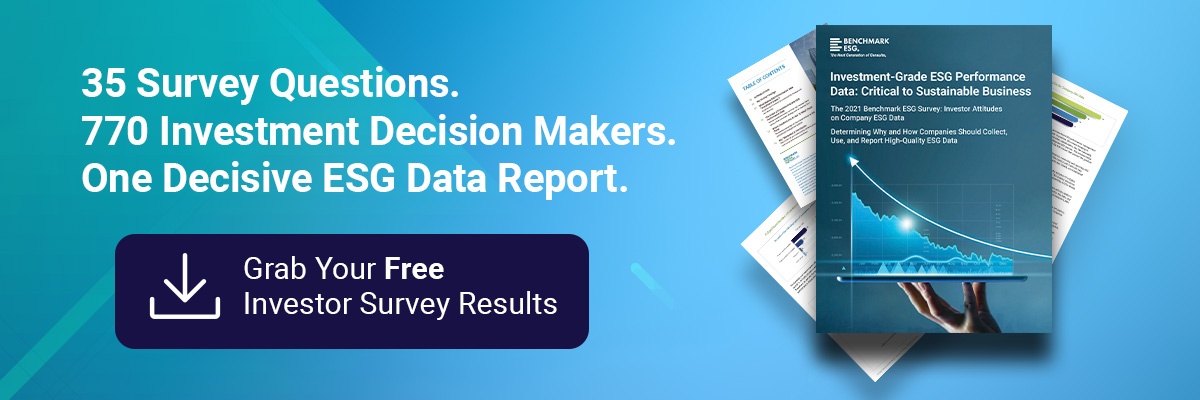In recent years, companies around the world have felt increasing pressure to disclose Environmental, Social, and Governance (ESG) data to satisfy investors and various internal and external stakeholders. Today, the trend toward mandatory reporting is accelerating—most recently reflected in the March 21, 2022 release of the U.S. Securities and Exchange Commission (SEC) proposed rule mandating reporting of certain Scope 3 emissions by non-smaller-reporting-company (SRC) registrants.
Under the proposed rule, affected companies would need to report material Scope 3 emissions, or report Scope 3 emissions covered by a company’s stated greenhouse gas (GHG) emissions reduction target. The concern among sustainability and ESG leaders is the complexity and difficulty involved in calculating Scope 3 emissions, which are produced by entities and activities outside of corporate operations and control. In fact, the types of Scope 3 emissions that companies struggle with most also have the greatest impact on climate.
Why Is Scope 3 So Intimidating?
Scope 3 emissions sources are neither owned as operating assets (Scope 1) nor used to power systems (Scope 2). They are peripheral to reporting companies’ core operations and include both upstream and downstream activities.

Source: Airbus.com
The mere thought of tackling Scope 3 can be overwhelming. Misconceptions about the difficulty of conducting a Scope 3 screening persist, but it’s a significant undertaking nonetheless. There are 15 distinct categories of Scope 3 emissions data, and companies that take this on (for voluntary ESG reporting, or mandatory reporting down the road) must not only determine which categories apply, but also capture and compile data up and down the value chain to determine the organization’s overall carbon footprint.
Scope 3 Emissions Categories
- Category 1 – Purchased goods and services
- Category 2 – Capital goods
- Category 3 – Fuel- and energy-related activities
- Category 4 – Upstream transportation and distribution
- Category 5 – Waste generated in operations
- Category 6 – Business travel
- Category 7 – Employee commuting
- Category 8 – Upstream leased assets
- Category 9 – Downstream transportation and distribution
- Category 10 – Processing of sold products
- Category 11 – Use of sold products
- Category 12 – End-of-life treatment of sold products
- Category 13 – Downstream leased assets
- Category 14 – Franchises
- Category 15 – Investments
For categories such as business travel and employee commuting, data collection isn’t a very big lift. But these categories also constitute a de minimis impact on overall Scope 3 emissions for most companies. The bulk of Scope 3 emissions are tied up in purchased goods and services—a category that ranks near the top for complicated and tedious data collection processes.
Which Scope 3 Emissions Sources Should You Prioritize?
Tackling Scope 3 emissions—not only for reporting, but also for setting and meeting meaningful and realistic GHG targets—starts with knowing where to focus your attention and efforts.
- Conduct a screening assessment of what is relevant and important to your company’s operations. You’ll also need to have an answer as to why you’re responding to the categories you’ve selected. Given the breadth and complexity of a Scope 3 assessment, you’ll likely need to consult with experts to ensure the assessment is accurate and complete.
- Focus on Tier 1 suppliers. If you cast the net too widely for the sake of capturing all possible Scope 3 data, you’ll run the risk of double counting emissions.
__________
Environmental consulting firms such as Antea Group specialize in helping companies understand their impact, operate more sustainably, and take meaningful action to protect the climate.
For help with Scope 3 screening assessments & emissions reporting, contact Antea Group today.
_____________

Scope 3 Data Collection and Reporting: How to Make It Work Long Term
Key to making Scope 3 manageable and successful is having the means to simplify and streamline data collection and reporting. For companies that operate widely, even globally, this means having tools that make it easy to collect data from disparate sources and calculate emissions with precision.
The most essential Scope 3 capabilities can be digitally enabled with ease. These include:
- A screening tool that can help you understand relevant Scope 3 categories based on what is applicable for each industry sector
- Automatic collection of raw inputs, with emissions calculated using global standard emission factors
- A supplier portal with the means to survey suppliers for sustainability inputs (i.e., usage data) and ensure calculation consistency across the supply chain
- Detailed calculators for the most common Scope 3 categories (e.g., purchased goods and services, capital goods)
- A way to document off-sheet calculations (via consultant or a third-party tool such as the Greenhouse Gas Protocol Scope 3 Evaluator) and aggregate to produce a single emissions footprint for the company
Many companies, including those that rely on the Benchmark Gensuite® Sustainability Reporting and Supplier Portal digital tools, have been calculating Scope 3 emissions for years. New digital innovations, developed in collaboration with both software users and expert partners, will soon offer additional best-practice methods that can make calculating Scope 3 emissions an even easier endeavor.
Meet the Growing Demand for Scope 3 Emissions Data . . . with Surprising Ease
Managing Scope 3 doesn’t need to be intimidating or resource draining. Digitally enabled organizations can eliminate the usual burdens, errors, and gaps in their data collection and reporting processes while seizing opportunities within the data to improve operational performance, sustainability, and business results.
Given the urgency of climate action, the pressure from investors, stakeholders, and regulators will only intensify. Now is the time to equip your enterprise for efficient, reliable Scope 3 emissions reporting—and in the process, find ways to minimize environmental impacts across your value chain.
Interested in Learning More?
To learn more about cloud-based digital solutions and best practices that can help you simplify Scope 3 data collection, calculations, and reporting, please join us for a webinar in May cohosted by Benchmark Gensuite® and Antea Group. Be sure to bookmark our Events page and check back for further details!
The Benchmark Gensuite® cloud-based software platform helps 350+ subscribers and more than 2.9 million users worldwide manage risk, reduce costs, ensure regulatory compliance, streamline ESG reporting, and deliver on sustainability and ESG commitments.
To learn about our industry-leading sustainability and ESG data management and reporting solutions, click on the links below!
[ Explore Our Sustainability Solutions ] [ Explore ESG Disclosure Director™ ]




